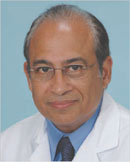Editor's Letter
Nov/Dec 2008 —
Vol. 2,
Iss. 5
From the Editor-in-Chief
Noshir R. Mehta, BDS, MDS, DMD, MS
Dear dental colleagues,
This issue of Dentistry India is dedicated to
the evidence that periodontal diseases have been shown to be significant in the general health of the human body.
From diabetes to cardiovascular disease, the
role of periodontal health continues to grow in importance as the world population continues to age.
Thirty-five years ago, when I was a graduate student
in periodontology, the emphasis was on saving teeth by oral hygiene
preventative programs and by surgical interventions for pocket reduction. Studies on bacterial infections leading to
periodontal diseases, and their treatments, were rightly aimed at dental
plaque and calculus as the primary etiologies. As the field continued to expand, it moved toward surgical treatments of the
effects of the diseases, and its sights shifted from prevention to the rebuilding of the damaged supporting structures. Techniques
became the primary educational focus and biomaterials the new frontier of implantology. Our efforts to save more teeth gave way to
the replacement of those same teeth we formerly tried to save, until new evidence heralded the advent of the host-response
concept.
Once periodontal diseases were seen to have an effect
on systemic health, the field refocused its attention on the host’s
response to the biofilm and inflammatory
related endotoxins, enzymes, and other cascading events leading to the
eventual destruction of the periodontium. Serum inflammatory markers like
C-reactive protein and interleukin-6, for example, are now being examined
as markers for the effects of successful
treatment, in addition to the simple clinical signs we all know.
Oral health preventive measures have also expanded
from a purely mechanical cleansing of the teeth to multidimensional approaches including antibiotic and antiinfective
medications carried to the tissues through brushes, mouthrinses, and oral
irrigators. Furthermore, the relationship of
inflammation and dental occlusion is again being reviewed, with renewed
interest in diabetes, cardiovascular disease, obesity, and sleep disorders.
The Indian Society of Periodontology meeting in
November in Chandigarh will be reviewing the latest evidence-based concepts
in this field. This issue of Dentistry India complements this meeting with a range of in-depth articles
contributing to this vital discussion. As the
official publication of the Dental Council of India (DCI), Dentistry India includes
educational articles in each issue. In the future, there will be a test
mechanism that will allow you to earn CDE credits accepted and recognized
by the DCI. In the meantime, the current
articles include answer keys so that you may test your knowledge and
familiarize yourself with how this process will
work when it becomes available.
If you or a colleague would like to subscribe to Dentistry India, you may sign up
for a free subscription at www.dentistryindia.net. On behalf of the DCI and the board of Dentistry
India, I thank you for your continuing
interest, and encourage your comments and submissions to this publication.
Sincerely,
 |
Noshir R. Mehta, BDS, MDS, DMD, MS
Professor and Chairman
Department of General Dentistry
Director
Craniofacial Pain Center
Assistant Dean
International Relations
Tufts University School of Dental Medicine
Boston, Massachusetts
Editor-in-Chief
Dentistry India |
|




